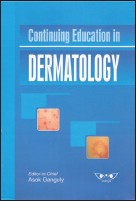Translate this page into:
Continuing Education in Dermatology
Correspondence Address:
Sanjay Singh
Department of Dermatology and Venereology, Institute of Medical Sciences, Banaras Hindu University, Varanasi-221005, Uttar Pradesh
India
| How to cite this article: Singh S. Continuing Education in Dermatology. Indian J Dermatol Venereol Leprol 2013;79:726-727 |
 Editior: Asok Ganguly
Editior: Asok Ganguly
Publisher: Kolkata: Adrija Publishers
Hardcover
Edition: First, 2013
Pages: 260
ISBN 978-81-924968-0-1
INR 600/-
Medical science is always changing, the change being driven by research. The enormous number of journals publishing the research makes it impossible for even a dedicated reader to keep informed of all, or even important, developments in one′s field. In this age of information explosion, the articles written by experts who summarize and provide important perspectives on the current developments are very important. The Editor-in-Chief writes in the preface "The present volume is a humble endeavor to incorporate some recent developments in dermatology." I can assure him that this objective has been ably met.
This is a multi-author book, with distinguished authors from India, USA, and UK. Forty authors have contributed 25 chapters. The areas covered in the book include: Dermoscopy; salivary diagnostics; autologous serum skin test; melasma and post-inflammatory hyperpigmentation; incontinentia pigmenti; vasculitis; leg ulcers; pattern alopecia; atopic eczema; pediatric psoriasis; hemangiomas; phototherapy and photochemotherapy; stem cells; immunopathological role of interleukin-17 in psoriasis; acute generalized exanthematous pustulosis; adverse cutaneous drug reactions; management of Stevens-Johnson syndrome and toxic epidermal necrolysis; new developments in genetics, molecular biology, diagnostics and therapeutics in relation to dermatology, human papilloma virus vaccine, human immunodeficiency virus and acquired immunodeficiency syndrome, leprosy, and aesthetic dermatology; community dermatology; managing a modern hospital; and dermatologic terminology. This is an impressive range of topics of interest to a dermatologist.
The chapter on dermoscopy describes characteristics of benign and malignant melanocytic lesions; salivary diagnostics focuses on types of salivary biomarkers and their potential applications in diseases of oral cavity and systemic diseases; autologous serum skin test is discussed with its procedure and application; some newer research on pathogenesis of melasma is summarized along with the differences among its types and the various available treatments; recent research on genes related to incontinentia pigmenti is summarized along with its history and clinical features including the diagnostic criteria; the chapter on vasculitis includes several schematic diagrams and diagnostic algorithm; the one on leg ulcers focuses on the different types of ulcers and their clinical features and management; in the chapter on pattern alopecia, recent advances in the roles of genes and androgen and the management are presented; and the chapter on atopic eczema focuses on the hygiene hypothesis, genetics, epidermal barrier, immune dysfunction, and treatment.
Treatment of pediatric psoriasis is discussed with emphasis on the nuances of treating a child; current concepts in hemangiomas are presented with clinical features, course, and treatment options; there is discussion on phototherapy and photochemotherapy along with newer developments; the chapter on stem cells covers the basics and the clinical applications with several diagrams; emerging immunopathogenic role of interleukin-17 and its potential for cytokine-based therapy in psoriasis is discussed; clinical features and differential diagnosis of acute generalized exanthematous pustulosis are presented along with its pathogenesis; and the chapter on adverse cutaneous drug reactions presents their classification, epidemiology, pathogenesis, clinical spectrum, diagnostic work up, and management.
The chapter on Stevens-Johnson syndrome and toxic epidermal necrolysis discusses their stepwise management in the intensive care unit; in the chapter on few recent developments in dermatology, the developments related to genetics, molecular biology, diagnostics, and therapeutics are presented; advances in human papilloma virus vaccine are summarized along with discussion on several new approaches; the chapter on human immunodeficiency virus and acquired immunodeficiency syndrome discusses pre-exposure prophylaxis, developments in drug therapy and vaccines; the chapter on leprosy discusses epidemiology and newer studies on transmission, pathogenesis, evaluation of neuritis, drug resistance screening, early detection, treatment and prevention, relapses and the interaction of leprosy and human immunodeficiency virus.
The concept of community dermatology as a new branch of dermatology providing skin care for all with low cost technology is presented along with a summary of the efforts being made in several countries; the chapter on aesthetic dermatology focuses on hair removal, fillers, lipolysis, and spa; management of a modern hospital is discussed with emphasis on quality and the scope of dermatology specialty hospital; and a glossary of 297 terms used by the dermatologists is presented in the last chapter of the book on dermatologic terminology.
All chapters are very well written, and the hard work of the authors is clearly visible. The chapters have comprehensive, but not exhaustive, list of references, many of them recent. The chapters have many nicely printed colored schematic diagrams and clinical photographs. The book has been printed on good quality paper, and its overall publication quality is comparable to an international publication.
To conclude, in my opinion, the book is good, worth your time spent in reading it, and is welcome. The book will be beneficial for anyone interested in dermatology, including the postgraduate students.
Fulltext Views
1,719
PDF downloads
1,637





